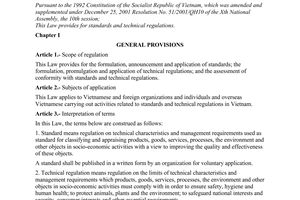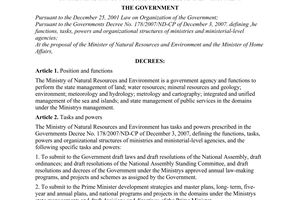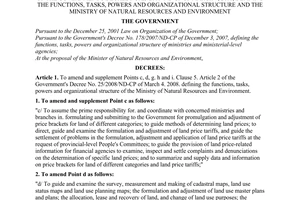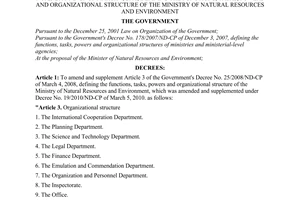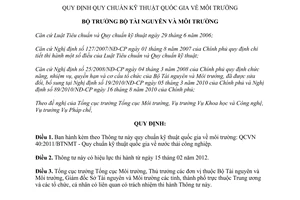Nội dung toàn văn Circular No. 47/2011/TT-BTNMT on national technical regulation on environment
|
MINISTRY OF NATURAL RESOURCES AND
ENVIRONMENT |
SOCIALIST REPUBLIC OF VIETNAM |
|
No. 47/2011/TT-BTNMT |
Hanoi, December 28, 2011 |
CIRCULAR
ON NATIONAL TECHNICAL REGULATION ON ENVIRONMENT
THE MINISTER OF NATURAL RESOURCES AND ENVIRONMENT
Pursuant to the Law on Technical regulations and standards dated June 29, 2006;
Pursuant to the Government's Decree No. 127/2007/ND-CP dated August 01 2007 detailing the implementation of a number of articles of the Law on Technical regulations and standards;
Pursuant to the Government's Decree No. 25/2008/ND-CP on March 04, 2008 on defining the functions, tasks, powers and organizational structure of the Ministry of Natural Resources and Environment; amended in the Government's Decree No. 19/2010/ND-CP dated March 05, 2010 and the Government's Decree No. 89/2010/ND-CP dated August 16, 2010;
At the request of the Director of the Vietnam Environment Administration, the Director of Science and Technology Administration, and the Director of the Legal Department,
PRESCRIBES:
Article 1. Promulgating together with this Circular the National Technical Regulation on Environment: QCVN 40:2011/BTNMT – National Technical Regulation on Industrial Wastewater.
Article 2. This Circular takes effect on February 15, 2012.
Article 3. The Director of Vietnam Environment Administration, Heads of units affiliated to the Ministry of Natural Resources and Environment, Directors of provincial Services of Natural Resources and Environment, relevant organizations and individuals are responsible for the Circular of this Circular.
|
|
PP. THE MINISTER |
QCVN 40:2011/BTNMT
NATIONAL TECHNICAL REGULATION
ON INDUSTRIAL WASTEWATER
Foreword
QCVN 40:2011/BTNMT supersedes QCVN 24:2009/BTNMT, is submitted by the Vietnam Environment Administration, the Science and technology Administration, and the Legal Department, and promulgated together with the Circular No. 47/2011/TT-BTNMT dated December 28, 2011 of the Minister of Natural Resources and Environment.
NATIONAL TECHNICAL REGULATION
ON INDUSTRIAL WASTEWATER
1. GENERAL PROVISIONS:
1.1. Scope of regulation
This Regulation provides for the maximum values of pollution parameters of industrial wastewater being discharged into receiving waters.
1.2. Subjects of application
1.2.1. This Regulation is applicable to organizations and individuals involved in the discharge of industrial wastewater into receiving waters.
1.2.2. Industrial wastewater of special industry is subject to separate National Technical Regulations.
1.2.3. Industrial wastewater being discharged into the collecting system of centralized wastewater treatment plants shall comply with the charters of the plants.
1.3. Interpretation of terms
In this Regulation, the terms below are construed as follows:
1.3.1. Industrial wastewater is wastewater produced from the technological processes of industrial facilities, from centralized wastewater treatment plants that are connected to the sewer system of industrial facilities.
1.3.2. Receiving waters are drainage system of urban areas and residential areas, rivers, streams, canals, channels, lakes, ponds, swamps; coastal water that have defined purposes.
2. TECHNICAL PROVISIONS
2.1. The maximum permissible values of pollution parameters in industrial wastewater being discharged into receiving waters.
2.1.1. Maximum permissible values of parameters of industrial wastewater being discharged into receiving waters are calculated as follows:
Cmax = C x Kq x Kf
- Cmax is the maximum permissible value of a pollution parameter of industrial wastewater being discharged into receiving waters.
- C is the value of a pollution parameter of industrial wastewater specified in Table 1;
- Kq is the coefficient of receiving waters specified in Point 2.3 which is correspond to the flow rate of the rivers, streams, canals, channels, or the volume of the lakes, swamps, or the purposes of coastal water;
- Kf is the coefficient of the flow rate of the receiving waters specified in Point 2.4 which corresponds to the total flow rate of wastewater discharged by industrial facilities into receiving waters;
2.1.2. Apply the maximum permissible value Cmax = C (not Kq and Kf) to the following parameters: temperature, color, pH, coliform, gross α activity, and gross β activity.
2.1.3. Industrial wastewater being discharged into the drainage systems of urban areas and residential areas without centralized wastewater treatment plants shall apply the value Cmax = C in Column B of Table 1.
2.2. Values of parameter of industrial wastewater (C) are specified in Table 1
Table 1. Values of parameter of industrial wastewater (C)
|
No. |
Parameter |
Unit |
Value (C) |
|
|
A |
B |
|||
|
1 |
Temperature |
oC |
40 |
40 |
|
2 |
Color |
Pt/Co |
50 |
150 |
|
3 |
pH |
- |
6 to 9 |
5.5 to 9 |
|
4 |
BOD5 (20oC) |
mg/l |
30 |
50 |
|
5 |
COD |
mg/l |
75 |
150 |
|
6 |
Suspended solids |
mg/l |
50 |
100 |
|
7 |
Arsenic |
mg/l |
0.05 |
0.1 |
|
8 |
Mercury |
mg/l |
0.005 |
0.01 |
|
9 |
Lead |
mg/l |
0.1 |
0.5 |
|
10 |
Cadmium |
mg/l |
0.05 |
0.1 |
|
11 |
Chromium (VI) |
mg/l |
0.05 |
0.1 |
|
12 |
Chromium (III) |
mg/l |
0.2 |
1 |
|
13 |
Copper |
mg/l |
2 |
2 |
|
14 |
Zinc |
mg/l |
3 |
3 |
|
15 |
Nickel |
mg/l |
0.2 |
0.5 |
|
16 |
Manganese |
mg/l |
0.5 |
1 |
|
17 |
Iron |
mg/l |
1 |
5 |
|
18 |
Total cyanide |
mg/l |
0.07 |
0.1 |
|
19 |
Total phenol |
mg/l |
0.1 |
0.5 |
|
20 |
Total mineral fats and oils |
mg/l |
5 |
10 |
|
21 |
Sulfide |
mg/l |
0.2 |
0.5 |
|
22 |
Fluoride |
mg/l |
5 |
10 |
|
23 |
Ammonium (as N) |
mg/l |
5 |
10 |
|
24 |
Total nitrogen |
mg/l |
20 |
40 |
|
25 |
Total phosphorus (as P) |
mg/l |
4 |
6 |
|
26 |
Chloride (not applicable when discharging into saline water and brackish water) |
mg/l |
500 |
1000 |
|
27 |
Excess Chlorine |
mg/l |
1 |
2 |
|
28 |
Total organochlorine pesticides |
mg/l |
0.05 |
0.1 |
|
29 |
Total organophosphorus pesticides |
mg/l |
0.3 |
1 |
|
30 |
Total PCB |
mg/l |
0.003 |
0.01 |
|
31 |
Coliform |
bacteria/100ml |
3000 |
5000 |
|
32 |
Gross α activity |
Bq/l |
0.1 |
0.1 |
|
33 |
Gross β activity |
Bq/l |
1.0 |
1.0 |
Column A in Table 1 indicates the values of parameters of industrial wastewater (C) when it is discharged into the water sources serving tap water supply;
Column B in Table 1 indicates the values of parameters of industrial wastewater (C) when it is discharged into the water sources not serving tap water supply;
The purpose of receiving waters is determined at the location into which wastewater is discharged.
2.3. Coefficient of receiving waters (Kq)
2.3.1. Coefficients Kq corresponding to the flow rate of rivers, streams, canals, channels, etc. are specified in Table 2 below:
Table 2: Coefficients Kq corresponding to the flow rate of receiving waters
|
Flow rate of receiving waters (Q) Unit: m3 per second |
Kq |
|
Q ≤ 50 |
0.9 |
|
50 < Q ≤ 200 |
1 |
|
200 < Q ≤ 500 |
1.1 |
|
Q > 500 |
1.2 |
Q is calculated according to the average flow rate of receiving waters in 3 driest months in 3 consecutive years (according to the data of meteorology and hydrography agencies).
2.3.2. Kq corresponding to the volume of receiving waters that are lakes, swamps are specified in Table 3 below:
Table 3: Kq corresponding to the volumes of receiving waters
|
Volume of receiving waters (V) Unit: m3 |
Kq |
|
V ≤ 10 x 106 |
0.6 |
|
10 x 106 < V ≤ 100 x 106 |
0.8 |
|
V > 100 x 106 |
1.0 |
V is calculated according to the average volume of the receiving lake or pond or swamp in 3 driest months in 3 consecutive years (according to the data of meteorology and hydrography agencies).
2.3.3. If the flow rate of receiving waters which is a river, stream, canal, or channel is unknown, then Kq = 0.9; if the volume of a lake, pond, or swamp is unknown, then Kq = 0.6.
2.3.4. Kq of receiving waters that are coastal saline water, coastal saline and brackish swamps.
For coastal saline water used for aquatic conservation, water sports and water recreation, coastal saline and brackish swamps, Kq = 1.
For coastal saline water not being used for aquatic conservation, water sports and water recreation, Kq = 1.3
2.4. Coefficient of discharge rate Kf
The coefficients of discharge rate Kf are provided in Table 4 below:
Table 4. Coefficients of discharge rate Kf
|
Discharge rate (F) Unit: m3/24h |
Kf |
|
F ≤ 50 |
1.2 |
|
50 < F ≤ 500 |
1.1 |
|
500 < F ≤ 5,000 |
1.0 |
|
F > 5,000 |
0.9 |
The discharge rate F is calculated according to the highest discharge in Environmental Impact Assessment Reports, Environment Protection Commitments, or Environment Protection Schemes.
3. DETERMINATION METHODS
3.1. Wastewater shall be sampled to evaluate quality in accordance with the guidance of the following National Standards:
- TCVN 6663-1:2011 (ISO 5667-1:2006) – Water quality -- Sampling -- Part 1: Guidance on the design of sampling programmes and sampling techniques;
- TCVN 6663-3:2008 (ISO 5667-3: 2003) – Water quality - Sampling. Guidance on the preservation and handling of water samples;
- TCVN 5999:1995 (ISO 5667 -10: 1992) - Water quality - Sampling - Part 10: Guidance on sampling of wastewaters.
3.2. Values of pollution parameters in industrial wastewater shall be determined according to the following national and international standards:
- TCVN 4557:1988 – Water quality – Method for determination of temperature;
- TCVN 6492:2011 (ISO 10523:2008) - Water quality -- Determination of pH;
- TCVN 6185:2008 – Water quality - Examination and determination of color;
- TCVN 6001-1:2008 (ISO 5815-1:2003), Water quality - Determination of biochemical oxygen demand after n days (BODn) -- Part 1: Dilution and seeding method with allylthiourea addition;
- TCVN 6001-2:2008 (ISO 5815-2:2003), Water quality - Determination of biochemical oxygen demand after n days (BODn) -- Part 2: Method for undiluted samples;
- TCVN 6491:1999 (ISO 6060:1989) - Water quality - Determination of the chemical oxygen demand;
- TCVN 6625:2000 (ISO 11923:1997) Water quality - Determination of suspended solids by filtration through glass-fibre filters;
- TCVN 6626:2000 - Water quality - Determination arsenic - Atomic absorption spectrometric method (hydride technique);
- TCVN 7877:2008 (ISO 5666:1999) – Water quality – Determination of mercury;
- TCVN 6193:1996 – Water quality – Determination of cobalt nickel, copper, zinc, cadmium, and lead. Flame atomic absorption spectrometric methods.
- TCVN 6222:2008 – Water quality- Determination of chromium - Atomic absorption spectrometric method;
- TCVN 6658:2000 - Water quality – Determination of chromium (VI). Spectrometric method using 1,5-diphenylcarbazide;
- TCVN 6002:1995 - Water quality – Determination of manganese - Formaldoxime spectrometric method;
- TCVN 6177:1996 - Water quality – Determination of iron - Spectrometric method using 1,10-phenantrolin;
- TCVN 6665:2011 (ISO 11885:2007) - Water quality -- Determination of selected elements by inductively coupled plasma optical emission spectrometry (ICP-OES);
- TCVN 6181:1996 (ISO 6703 -1:1984) - Water quality - Determination of total cyanide;
- TCVN 6494-1:2011 (ISO 10304 -1:2007) - Water quality -- Determination of dissolved anions by liquid chromatography of ions -- Part 1: Determination of bromide, chloride, fluoride, nitrate, nitrite, phosphate and sulfate;
- TCVN 6216:1996 (ISO 6439:1990) - Water quality -- Determination of phenol index -- 4-Aminoantipyrine spectrometric methods after distillation;
- TCVN 6199-1:1995 (ISO 8165/1:1992) - Water quality -- Determination of selected monovalent phenols -- Part 1: Gas-chromatographic method after enrichment by extraction;
- TCVN 5070:1995 – Water quality - Weight method for determination of oil and oil product;
- TCVN 7875:2008 – Water - Determination of oil and grease - Partition-infrared method;
- TCVN 6637:2000 (ISO 10530:1992) - Water quality - Determination of dissolved sulfide - Photometric method using methylene blue;
- TCVN 5988:1995 (ISO 5664:1984) - Water quality -- Determination of ammonium -- Distillation and titration method;
- TCVN 6620:2000 - Water quality - Determination of ammonium - Potentiometric method;
- TCVN 6638:2000 – Water quality - Determination of nitrogen - Catalytic digestion after reduction with devarda's alloy;
- TCVN 6202:2008 (ISO 6878:2004) - Water quality -- Determination of phosphorus -- Ammonium molybdate spectrometric method;
- TCVN 8775:2011 - Water quality - Total coliform - Membrane-filter technique.;
- TCVN 6187-1:2009 (ISO 9308-1:2000) - Water quality - Detection and enumeration of Escherichia coli and coliform bacteria - Part 1: Membrane filtration method.
- TCVN 6187-2:1996 (ISO 9308 -2:1990(E)) – Water quality - Detection and enumeration if coliform organisms, thermotolerant coliform organisms, and presumptive Escherichia coli - Part 2: Multiple tube (most probable number) method;
- TCVN 6225-3:2011 (ISO 7393-3:1990) - Water quality - Determination of free chlorine and total chlorine - Part 3: Iodometric titration method for the determination of total chlorine;
- TCVN 7876:2008 – Water - Determination of organochlorine pesticides content. Liquid-liquid extraction gas chromatographic method
- TCVN 8062:2009 - Organophosphorus compounds by gas chromatography - Capillary column technique
- TCVN 6053:2011 - Water quality - Measurement of gross alpha activity in non-saline water - Thick source method;
- TCVN 6219:2011 - Water quality - Measurement of gross beta activity in non-saline water.
3.3. The analysis methods with equivalent or higher accuracy than that of the standards cited in Point 3.2, and the new national and international standards that are not cited in this Regulation are accepted.
4. IMPLEMENTATION
4.1. This Regulation supersedes QCVN 24:2009/BTNMT - National Technical Regulation on Industrial Wastewater promulgated together with the Circular No. 25/2009/TT-BTNMT dated November 16, 2009 of the Minister of Natural Resources and Environment.
4.2. People’s Committees of central-affiliated cities and provinces shall announce the purposes of water sources and the coefficient Kq when planning the use of water sources and zoning receiving waters.
4.3. State agencies in charge of environmental issues shall select typical parameters and basic values (C) in Table 1 to control environmental pollution depending on the characteristics of industrial wastewater and the purposes of the receiving waters.
4.4. When the national standards cited in this Regulation are amended or superseded, the new standards shall apply.
------------------------------------------------------------------------------------------------------
This translation is made by LawSoft and
for reference purposes only. Its copyright is owned by LawSoft
and protected under Clause 2, Article 14 of the Law on Intellectual Property.Your comments are always welcomed
